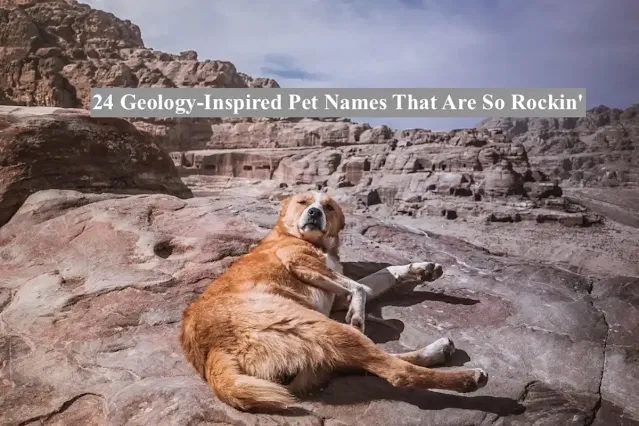24 Geology Inspired Dogs, Cats, and Pets Names
Here are 24 geology-related Dogs, Cats, and Pets names along with their geological meanings:
24 Geology-Inspired Pet Names
Obsidian: A naturally occurring volcanic glass formed when lava cools rapidly. It is typically black or dark brown, but can also be found in other colors, such as red, green, and yellow. A name for a pet with a sharp look or personality.
Jasper: A type of chalcedony, a microcrystalline quartz. Jasper is typically opaque and can be found in a variety of colors, including red, yellow, brown, green, and black. Great for pets with mixed or unique color patterns.
Flint: A hard, sedimentary form of quartz, known for sparking when struck. Good for a pet with a sparky or lively nature.
Mica: A group of minerals that are characterized by their ability to split into thin sheets. Mica - Known for its shiny, sheet-like layers. A fitting name for a pet with a sparkling or shiny coat.
Breccia: A rock composed of broken fragments of other rocks that have been cemented together.
Chert: A type of microcrystalline quartz that is typically dark gray or black in color.
Gabbro: A type of mafic intrusive igneous rock that is composed mainly of pyroxene and plagioclase feldspar.
Schist: is a medium-grained metamorphic rock that has a platy or foliated texture. Could fit a pet that's subtle or has layers to their personality.
Greywacke: A type of sedimentary rock that is composed of a mixture of sand-sized grains of quartz, feldspar, and other minerals.
Geode: A hollow rock that is lined with crystals. Geodes can be found in a variety of colors and shapes, and are often used as decorative items.
Iris: A rainbow of color in a stone!
Basalt: A common igneous rock formed from the rapid cooling of basaltic lava. Great for a pet that's cool and solid.
Drusy: A term used to describe a rock that is covered in small, needle-like crystals.
Lava: Molten rock that erupts from a volcano. Lava can be found in a variety of colors and textures, depending on its composition.
Onyx: A banded variety of chalcedony. a microcrystalline variety of quartz. Black onyx could be perfect for black pets or those with a mysterious aura.
Jet: is a type of coal that is formed from the remains of trees that have been buried in anaerobic conditions.
Marble - A metamorphic rock composed of recrystallized carbonate minerals. Elegant for a pet with a glossy or marbled coat.
Scoria: is a dark-colored, vesicular volcanic rock that
is formed when molten rock is ejected from a volcano and cools rapidly
in the air.
Tuff: A rock made of volcanic ash. A playful name for a pet with a tough exterior but soft at heart.
Ash: is a type of pyroclastic material that is composed of small fragments of volcanic rock, glass, and minerals.
Moho: is the boundary between the Earth's crust and the mantle. It is named after Andrija Mohorovičić, the Croatian seismologist who first identified it in 1909.
Slate is a type of metamorphic rock A fine-grained metamorphic rock (formed when shale is subjected to heat and pressure), that splits easily into thin slabs. Good for a pet that's sleek or has a smooth, layered look.
Topaz is a type of mineral that is typically colorless
or white, but it can also be found in other colors, such as blue, pink,
yellow, and green. Ideal for pets with a topaz-colored coat or eyes.
Opal is a type of mineral that is composed of hydrated silica.
Skarn: is a hard, coarse-grained metamorphic rock that form by a process called metasomatism.
Talc: is a naturally occurring mineral substance used in a variety of cosmetic and personal care products from baby powders to eye shadows.
Lapis: Short for Lapis Lazuli, known for its deep blue color. Perfect for pets with striking blue features.
Amber: Not a rock, but fossilized tree resin, often containing preserved insects. Suitable for a pet with a golden coat or a timeless charm.
Pumice: A light, porous volcanic rock. Ideal for a light-colored or fluffy pet that's full of air (or energy).
Why Choose a Geology-Inspired Name for your pet?
There are many reasons why you might choose a geology-inspired name for your pet. Perhaps you are a geologist yourself and want to share your love of the Earth with your furry friend. Or maybe you simply appreciate the beauty and variety of rocks, minerals, and geological features. Whatever the reason, a geology-inspired name can be a unique and meaningful way to identify your pet.
Geology is a fascinating subject that can teach us a lot about the world around us. Naming your pet after a geological feature or mineral can be a fun way to share your love of geology with them.
Geology-inspired names can be unique and interesting. If you want your pet to have a name that stands out from the crowd, a geology-inspired name is a great option.
Geology-inspired names can be fun and playful. If you have a playful and outgoing pet, a geology-inspired name that is also fun and playful can be a great fit.
To reflect your own interests. If you are passionate about geology, a geology-inspired name can be a way to show your love of the subject and share it with your pet.
To celebrate the natural world. Rocks, minerals, and geological features are all part of the natural world, so a geology-inspired name can be a way to celebrate the beauty and wonder of nature.
Looking for a Unique Pet Name? Here Are 24+ Geology-Inspired Options









